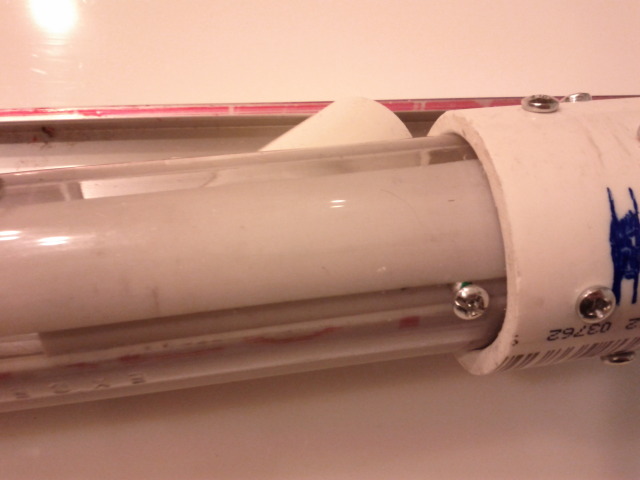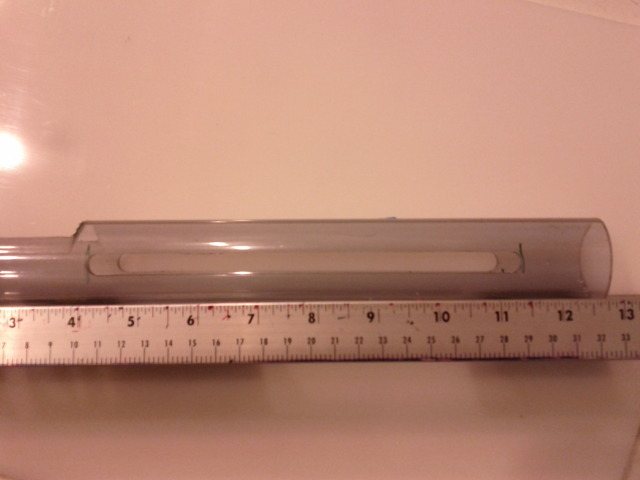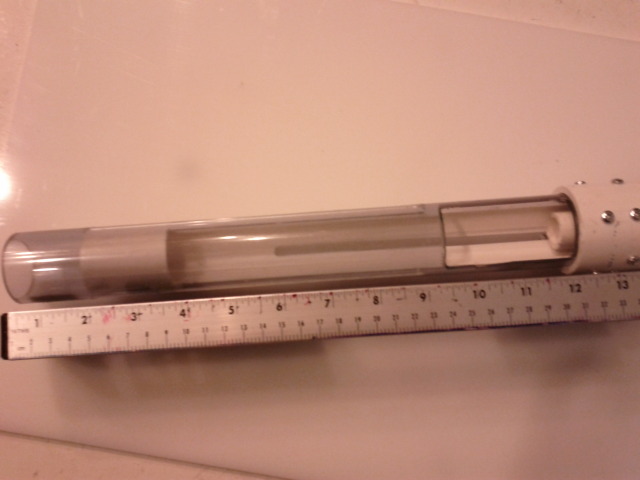

I rebuilt this design http://nerfhaven.com...showtopic=21567to not be completely awful. snakerbot gets at least 50% of the credit.
Materials:
-1-1/4" PVC (clear makes construction easier)
-1" thinwall PVC (critical to fit around 1/2" fittings, not critical if using a breech)
-7/8" ID x 1-3/8" OD U Cups 9691K56
-1/4" aluminum rod (substitutable)
-1/2" Delrin rod (substitutable)
-9/16" ID x 5/8" OD nylon tube 8628K57 (substitutable)
The priming pump is now constructed out of 1" thinwall PVC. The seal is created by sandwiching a u-cup between 1/2" PVC and 1/2" PVC couplers. The couplers then fit inside the 1" thinwall.
Channels are cut into the priming pump to fit around a wye. The stub of 1/2" PVC that extends through the u-cup seats with the wye.
The plunger rod consists of a length of 1/4" aluminum rod. The catch notch is created by turning 1/2" rod on a lathe to create the sloped omnidirectional ramp. A 1/4" hole is bored for the rod and secured with a set screw.
The plunger head is created by the same mechanism of 1/2" PVC and u-cup. It is seated between a section of 1/2" coupler and a 1/2" x 1" bushing. The plunger head is attached to the plunger rod via reducing the 1/2" PVC to 1/4" ID through tubes and 1/2" rod and then fastened to the plunger rod.
The plunger rod is cut to length so that the catch face meets with the catch at draw, thus it must be shorter than that length at rest
The catch is a standard rainbow catch, except with a 5/8" hole at the spring rest. This houses the 5/8" OD tube which fits inside the spring and yet is wide enough to allow unrestricted travel of the plunger rod and catch nub. This prevents spring buckling during compression which would cause tons of issues. I used a [k26] spring; use of a [k25] spring would enable 1/2" PVC to be used to center the spring (or some other tube of choice).
The trigger this time is mechanically linked from a rear trigger to front trigger via metal rod. This method is far superior than cutting a single large trigger. With better crafting of the rear trigger, you can use the physics of lever arms so that the trigger pull is much smoother (I was not paying attention and have a 1:1 ratio of horizontal to vertical movement. A 3:1 ratio would alleviate some of the stress on the stock trigger).
Functionally, this blaster is identical to the FAL-1. It is pump action except the pump runs coaxial and interior of the plunger tube, alleviating the need for linkages that would increase the length of the blaster.
The blaster is attached to the lower trigger housing (appropriated firefly shell) via polyethylene blocks. The blaster can be considered "unibody" except the 1-1/4" PVC body is segmented by couplers to allow for attachment points to the lower trigger housing and also to greatly ease construction and disassembly.
The barrel is held in place by a bushing at the front.
The blaster including barrel is approximately 30" long to the front bushing (the barrel in place is not the correct length). Here is a comparison shot with Ryan's newly shortened tubing blaster with vertical pump grip. Around 4" of the blaster can be cut down by rebuilding the front of the blaster more efficiently.
(Rebuilt to cut off 4" from the front)
Edited by CaptainSlug, 01 November 2017 - 07:44 AM.

































